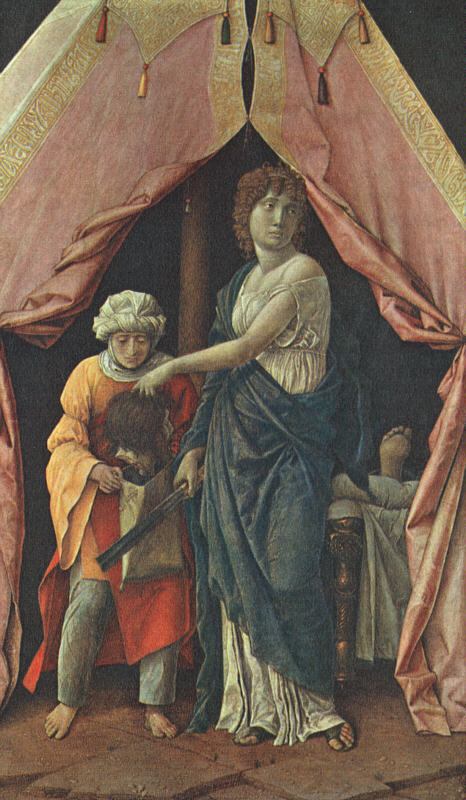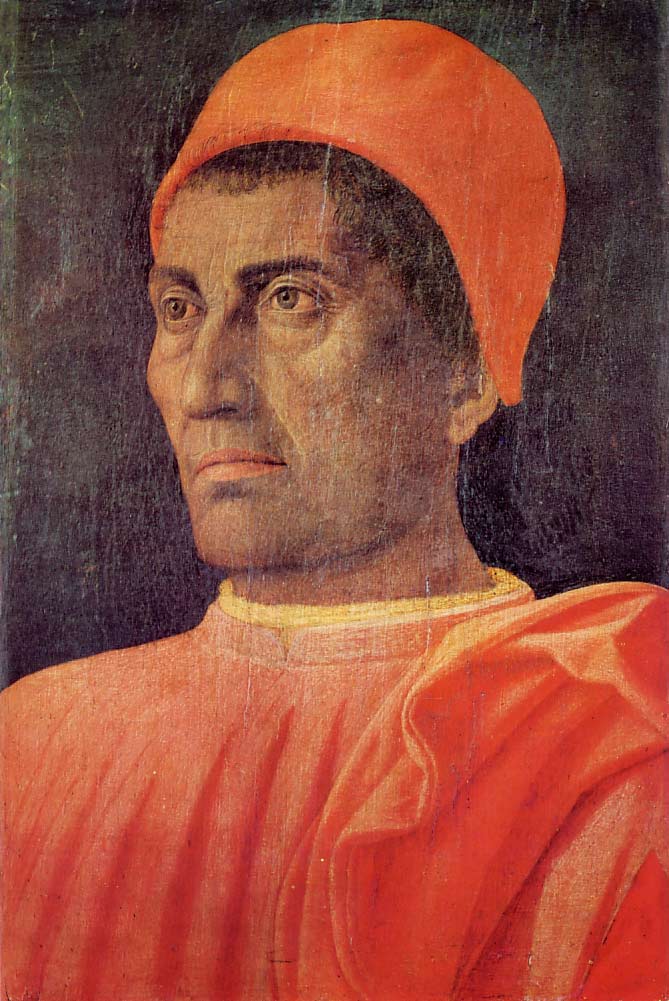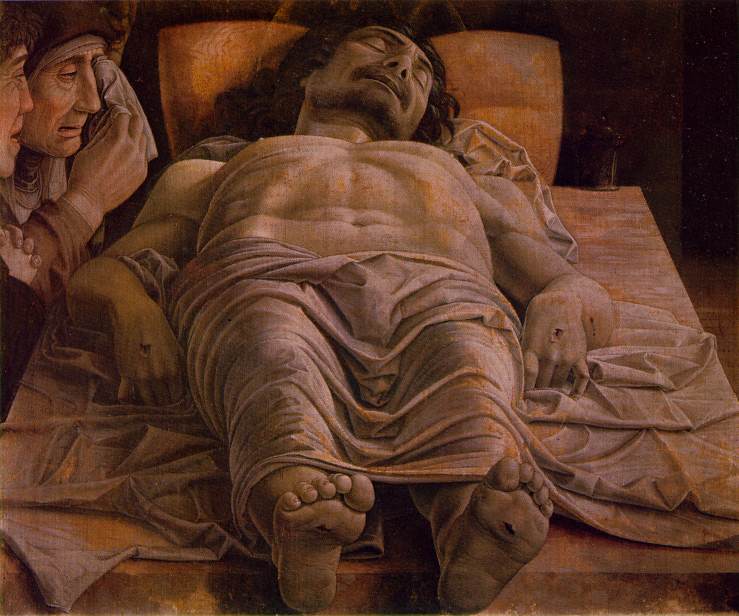(1431-1506)Activity: Painter and printmaker Andrea Mantegna was born in 1431 in Padua, one of the intellectual capitals of Italy alongside Rome and Florence. Annexed in 1405 by the Republic of Venice, the town counted many scientists and artists who worked for Venetian patrons.
In Padua, one of the most famous collection of art objects was owned by Squarcione who was to become the master and the adoptive father of Mantegna who had also the opportunity of admiring Giotto's frescoes in the Scorvegni della Arena chapel and in the Il Santo basilica as well as Donatello's bas reliefs and sculptures.
Benifiting from the artistic influences of Florence and Venice and much impressed by archaelogical findings in Northern Italy, Mantegna frequented Squarcione's school of painting where he learned to paint garlands of flowers and fruit baskets in the manner of miniaturists of his time. Mantegna's life long passion for Classical antiquity was also given ample early nourishment through the archaeological interests of Squarcione..
However, it was Donatello who influenced him much regarding the way he should draw and deal with volumes and perspective. Through his marriage, which enabled him to be linked to the Bellini family, Mantegna then managed to become a colourist of much repute.
After his apprenticeship with Squarcione, which he terminated at the age of 17 Mantegna's earliest independent commission was for the fresco decorations of the Ovetari Chapel of the Eremitani Church in Padua (1459, largely destroyed in the Second World War). These scenes, particularly the St. James Led to Execution, displayed a certain mastery of perspective unrivalled in any contemporary paintings. Furthermore, Mantegna's understanding of anatomy and his archaeological exactitude were fully in evidence. The influence of Donatello was even more palpable in Mantegna's next commission, the San Zeno Altarpiece (late 1450s, Verona, S. Zeno). The spatial construction of the painted all'antiqua hall in which the Madonna and Child and attendant saints stand coincides with the actual frame, such that the painted architectural setting relates to the actual entablature and four wooden columns of the altarpiece's frame; thus the frame itself simulates the front of a Classical temple. He executed six frescoes relating to the life of Saint James and already proved to be a virtuoso in the art of perspective as well as a pioneer in the representation of landscapes in painting.
Mantegna was therefore the first painter in the history of painting to produce scenes with landscapes and architectural settings. He also painted several works representing San Sebastian, which marked a deep confrontation between humanism of the Renaissance period and the mysticism of the Middle ages.

Judith and Holofernes
1495
Egg-tempera on wood
National Gallery of Art, Washington

The Agony in the Garden
c. 1450
Tempera on wood
63 x 80 cm
National Gallery, London
In 1453, Mantegna married Jacopo Bellini's daughter. Both he and his new brother in law, Giovanni Bellini, used a drawing of Jacopo's as a basis for an Agony in the Garden (c 1455, both London, National Gallery): a comparison of the two reveals the fundamental difference between Mantegna's sculptural conception and the new conception, that of forms modelled by colour and light, their edges softened by atmosphere, that Giovanni was to evolve for Venetian painting.
Mantegna also went to Mantua after decorating the San Zeno Church in Verona. working under the protection of Louis 3rd of Gonzaga from 1460, he produced many religious paintings, including "The Circumcision" triptych , one of his best works (Uffizi, Florence), as well as portraits. His most important work in Mantua was the decoration of the Camera degli Sposi (the Bridal Chamber, completed in 1474) of the Palazzo Ducale. He again displayed his mastery of perspective as well as his skills as a portrait painter in the representations of the Gonzaga family and court.
Perhaps the most significant part of such decoration was the painting of the ceiling, the middle of which is illusionistically opened up to the sky for the first time since antiquity. From over the fictive balustrade of a circular balcony, figures appear to look down into the room below. Such convincing illusionism was not accomplished again until Raphael in the Vatican and Correggio at Parma before reaching its consummation in the stunning illusionism of l7th century Baroque ceilings in Rome.
After the deaths of Louis and of his son Frederick 1st, he worked for John Francis 3rd who asked him to paint the series of nine monumental canvases of the Triumphs of Caesar (c 1486, Hampton Court) which, in addition to all his usual characteristics, revealed Mantegna's interest in antique bas reliefs and his inclination to resort to some great fantasy. For Isabella d'Este, the wife of Francesco Gonzaga, Mantegna painted the Madonna della Vittoria (1495-6) and the Parnassus (both Paris, Louvre). Mantegna was also important as a graphic artist, his many engravings exerting a powerful influence on Durer.

Portrait of Cardinal Carlo de' Medici
1466
Tempera on wood
40.5 x 29.5
Uffizi, Florence
While "The Triumphs of Caesar" proved to be the masterpieces of his career during which he continued to produce many religious paintings looking incredibly fresh nowadays, Mantegna also painted mythological paintings that were full of grace but faced difficulties during the early 1500s. Much annoyed by the conduct of his eldest son named Francis, he favoured his other son Louis in his will and asked to be buried in the San Andrea Chapel, a wish that was accepted in August 1504. From then on, his health declined before he died on September 13th 1506 at his home packed with antique findings he cherished much.
In his studio, his sons found two works, one showing San Sebastian and the other called "Cristo in scuro" or "Christ's Lamentations", one of the most terrifying representation of a dead Christ with those of Grünwald in Colmar and Holbein in Basel. In this extraordinary painting, Christ is shown laying on a slab evoking a dissection table, his head slightly raised and looking appeased, death being rendered much patent by the contrast of the faces of two weeping women lamenting over his body while the wounds of the martyr are shown with minute precision. It seemed that Mantegna wanted here to produce a frightening scene with the aim of exhaling the best of his resources. In this extraordinary painting, he at last managed to achieve a much decisive break between the art of the Middle Ages and that of the Renaissance.

The Lamentation over the Dead Christ
c. 1490
Tempera on canvas
68 x 81 cm
Pinacoteca di Brera, Milan